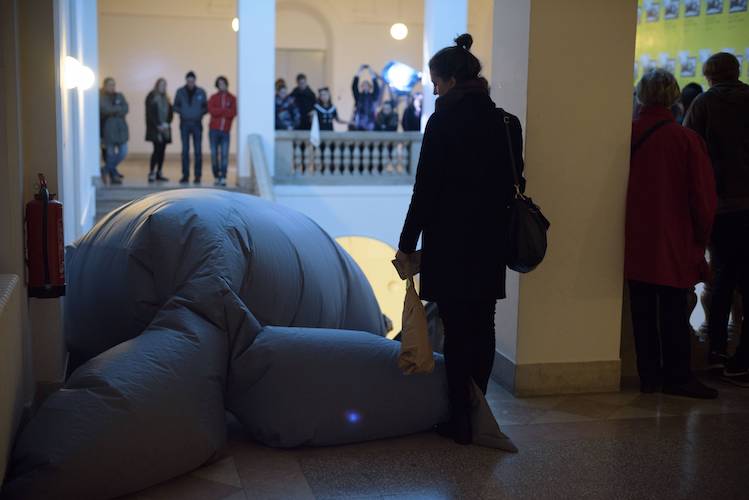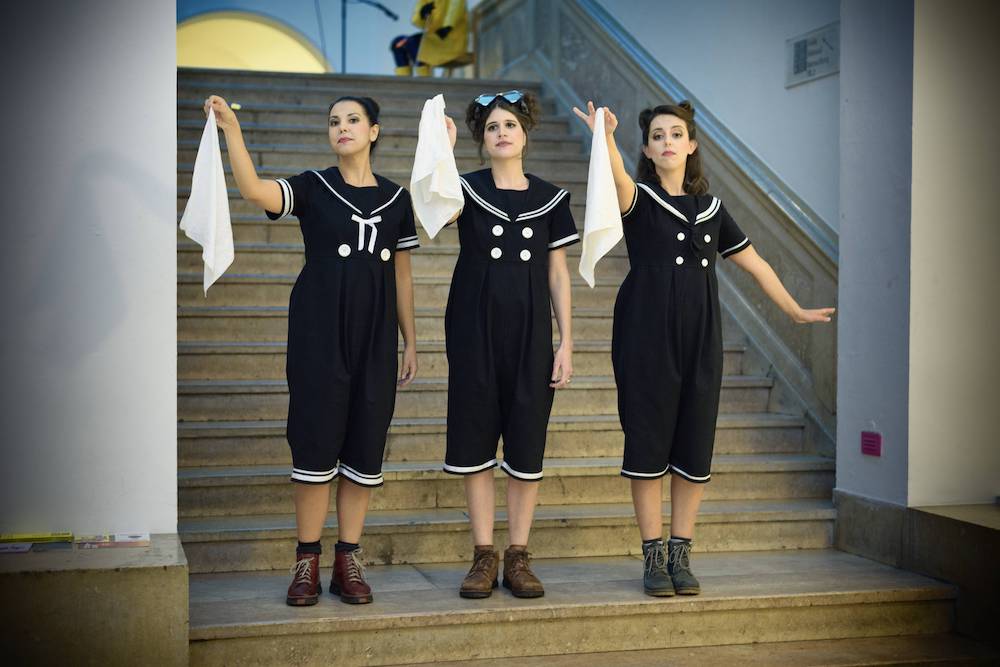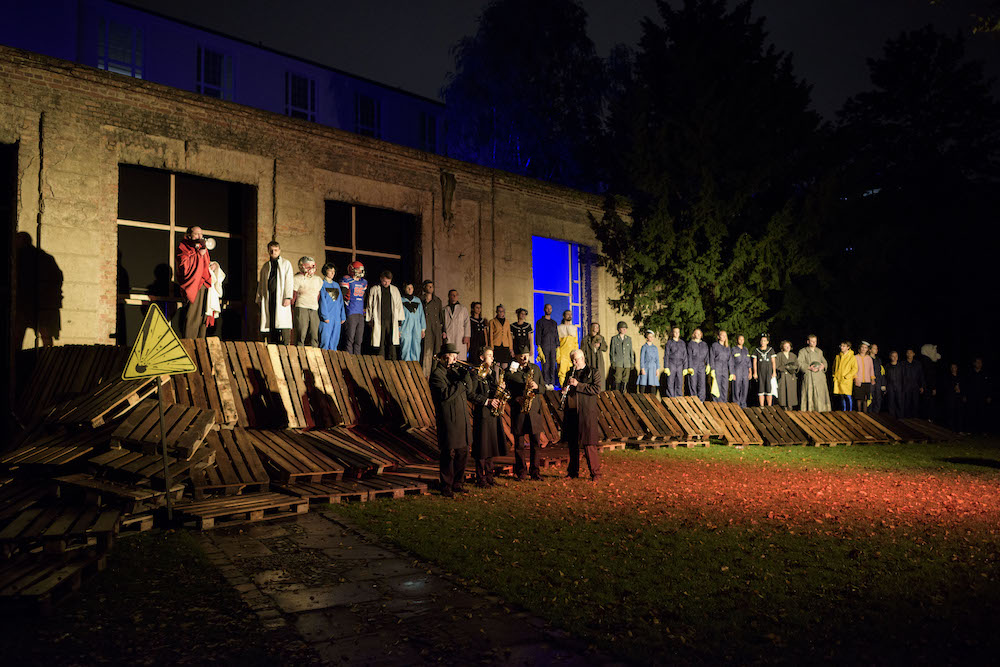
As so many good and terrible things, it started with a call and a simple question. Unlike most other things, the question was: would I like to perform with a seven-metre-long whale? …Yes, yes I would.
The whale was to be life-size, I learned, not live. Inflatable. A life-size whale balloon, essentially. I'm not sure I really believed the caller, but I said a definitive yes, anyway. In my experience, one does not turn down such invitations (or perhaps more accurately: I don't turn down such invitations).
It was a former fellow student of mine, Marie Schleef1, who had since begun the directing program at the auspicious Hochschule für Schauspielkunst Ernst Busch, and has since then begun endeavours even more auspicious. The directing students there had an intermittent collaboration with the scenic design students at the Universität der Künste Berlin, and Marie had been paired with Maria Frastanli to create one of some dozen scenes, to be scattered around the historicist UdK building on the Hardenbergstraße, with tall, echoing corridors, a landscaped courtyard, and a large atrium. Among this stone architecture, the several vignettes were scattered, each representing some kind of ghost of other worlds or ages past (the title 'Fantomoj' is Esperanto for 'ghosts' or 'phantoms'), which Marie in collaboration with Marie Baumgarten organized into a tour—what in German one can call 'Rundigang', in French one can call 'parcours', and which English doesn't really have a nice word for2. So my scene created by Marie-Maria was one piece of a puzzle directed by Marie-Marie, and though I performed mostly alone, it was perhaps the largest cast in total I've thus far worked with.

Into one of the flights of an imperial staircase, completely blocking it, the balloon was inflated, the shape and size of a juvenile sperm whale (the adults of which average 11–16 metres). This was assembled, under Maria's design, by the costume department, who sewed together segments of an airtight fabric, a kind of flaying in reverse—and if they blinked at this or any of the other extraordinary requests from student projects, I never saw it. For me, they laboured on what looked like a cross between a fisherman's rain gear and an infant's onesie.
I was incarnating a real whale expert, named of all things Aart Waalen (a Dutch name, but which sounds in German like Art (der) Wale 'type of whales'), who frequently consulted on the proper dissection and transport of whale carcasses, whenever they turn up dead on European beaches or floating in the British Channel. Marie had unearthed just about every public interview, text, video, or audio, that he had done, and collaged them together to form the basis of the text.
When a whale dies, whether from age, sickness, poisoning, or any other cause where the body is mostly intact, its thick blubber insulates gasses given off by microorganisms rotting the corpse from escaping; they build up within the body cavity, and buoy the ex-whale to the surface, where it floats until it ruptures and sinks to the bottom, or washes up on a shore. In addition to the scientific value of adding the skeleton to any number of natural history museums, if not disposed of properly, it bears a serious risk of exploding—especially if aided, as I made sure to observe in the course of my research.
All this I would explain and narrate in front of the massive whale; but Marie had further ideas: instead of a straight representation of the whale expert, she rewrote the text to focus on the physicality of dissection, the blood, guts, blubber, and bone, and imagined a dissection consultant who was less professional scientist and more excitable fetishist. My soliloquy would describe the ins and outs of massive mammal deconstruction, how one carves steps into the blubber to climb up the carcass, how it is slit open to release the foul gasses and carved up into blocks of muscle and connective tissue, the ligaments rent and the bones separated for transport, before the consultant is overcome with desire and dives cackling back into the whale from which he emerged. Befitting, in a certain way, for a strange spectre.

The audience for this scene has been led in from the last one (some kind of Rube Goldberg machine, I am told) by a trio of Greek singers dressed in sailor's costumes wailing (no pun intended, really) folk mourning melodies, and have gathered around the balustrade at the top of the stairs, where the singing is joined by a whale call, played on the saw by Marie's boyfriend, Cameron Seglias, a poet & playwright in his own...right. The whale seems to heave with the song, before I emerge from it, notice the audience as if surprised, and perform my soliloquy as if lecturing to a tour group arrived unexpectedly early, to find me doing...something...inside the whale; afterwards, the whale's song merges with that of the singers, who drag the inflatable carcass out of the way for the audience to pass onward and continue their tour of the improbable (including soldiers carrying an enormous shoe, American football players, and Korean water ghosts with false feet). At the end, we all gathered in the courtyard, emerging from the landscape to line up and jump into a plywood volcano, while a brass band played us out.

Though my part in it was effectively a single scene, the enormity of the production, the care for and organization of every detail, and the bravado with which the absurd was performed for all it was worth2 was a wonderful introduction to contemporary German theatre (and to performing in German to boot). There were also a number of narrative threads for me which started here: I first met the incomparable Cristián Lehmann Carrasco here, who is an excellent and accommodating actor (his work in Marie's Die Fahrt zum Leuchtturm and his solo show Leonce the King I would particularly point out), and who would later co-direct Das Kunstraubkabinett at Acker Stadt Palast two years later; though I was to meet the co-founders of REPLICA only a month later and perform with them first, I first began to fall into the gang of stage designers sometimes working under the moniker FCDU here, and eventually take part in pieces like Lafisinsiär: das all inclusive Europe special; most importantly, the gravitational well that dragged me into the latter was the stage designer Iris Christidi(s), who was to become more important to me than I could dream at the time. Then, I could only say what a pleasure it was brush by all of the diverse and engaging cast, to work directly with Cameron and the chorus, who are extremely talented singers, and to be directed by Marie, whom I have to thank for the chance, and all of the good futures it spawned.